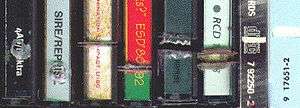Cut-out (recording industry)

In the recording industry, a cut-out refers to a deeply discounted or remaindered copy of an LP, 45 RPM single, cassette tape, Compact Disc, or other item.
History

When LPs were the primary medium for the commercial distribution of sound recordings, manufacturers would physically cut the corner, punch a hole, or add a notch to the spine of the jacket of unsold records returned from retailers; these "cut-outs" might then be re-sold to record retailers or other sales outlets for sale at a discounted price. 45 RPM singles records were usually drilled with a hole through the label, or stamped "C.O.". A special section of a record store devoted to such items was known as the cut-out bin or bargain bin.[1][2]
As tapes and CDs supplanted LPs, the mechanisms for indicating a cut-out changed. On cassettes, a hole tended to be punched or burned through the case and through its printed insert. On CDs (a practice that continues today), a section of varying size is taken out of the spine of the jewel case and its paper track listing. Other methods of cutting CDs include punching a hole through the UPC and clipping a corner off of the front insert.
Cut-outs are typically wholesaled to retailers as non-returnable items, meaning that the store cannot send them back to the distributor for a refund; the reason for the cut or hole in the packaging is to mark the item as non-returnable.[2] The marking also serves to prevent the retailer from selling the discounted item at full price.[1] Recording artists also typically do not get full royalties from cut-outs, since they're sold at a "promotional" cost, far less than the retail price.[1] Except for the physical damage to the liner notes and outer case, the inner disc (LP or CD) is generally unharmed by the cut-out process, and sounds the same as the originally sold recording.
A similar cut-out procedure was practiced with the laserdisc home video format as well as the 8-track tape cartridge. The practice has also been extended to DVDs, Blu-ray Discs, and other home video physical formats.
Dakou cassettes and CDs in China
Cut-out (Chinese: 打口; pinyin: dǎkǒu) cassettes and CDs played an important role in the development of rock music in China.[3] Dakou was the major and often the only source of foreign rock and pop music in China.[4]
See also
References
- 1 2 3 "Foetusized Attempts to Explain Cut-Out & Promo CDs". Foetusized.org. 2005-12-30. Archived from the original on July 19, 2011. Retrieved 2010-01-28.
- 1 2 "Music formats discussed, The Cut-Out". Moremusic.co.uk. Retrieved 2010-01-28.
- ↑ http://www.danwei.org/china_books/jeroen_de_kloets_china_with_a.php China with a Cut by Jeroen de Kloet, extract from pp. 17-25
- ↑ http://www.time.com/time/magazine/article/0,9171,409647,00.html Zombie Discs, by Neil Gough, Time magazine, 20 Jan 2003